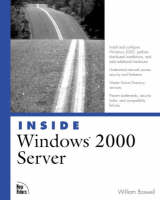
Inside Windows 2000 Server
Sams Publishing (Verlag)
978-1-56205-929-3 (ISBN)
- Titel ist leider vergriffen;
keine Neuauflage - Artikel merken
If you're a system administrator or an architect, a field technician or a help desk administrator, you need answers to four key questions about Windows 2000 Server technology: How is each major feature designed? How does it work in production? How does it work in production? What happens when it breaks, how do I fix it? Inside Windows 2000 Server answer those questions. Author William Boswell specializes in system and network administration for large-scale Windows NT/2000 networking environments. He has an in-depth understanding of the types of network problems that can arise and calls on his expertise to create a variety of common and not-so-common Windows 2000 problems. In an efficient, task-based format, Boswell provides strategies and specific procedures for installing, configuring, deploying and managing Windows 2000 servers and workstations in diverse enterprise networks.
William Boswell, MCSE, is a Senior Consultant for ASA Solutions, a telecommunications and network services firm based in Scottsdale, Arizona. He has extensive experience in the design and management of NT-based information systems. In addition to his project management responsibilities, Mr. Boswell is also an accomplished instructor with a unique sense of humor and a flair for analogy that that earns him enthusiastic commendations from his students. He can be reached at boswell@primenet.com.
1. Installing and Configuring Windows 2000.
Hardware Recommendations. Installation Checklist. Functional Overview of Windows 2000 Setup. Installing Windows 2000 Using Setup Disks. Correcting Common Setup Problems. Moving Forward.
2. Performing Upgrades and Automated Installations.
Functional Description of the Windows 2000 Boot Process. NT4 Upgrade Overview. Upgrading NT4 Server or Workstation. Windows 9x Upgrade Functional Overview. Upgrading Windows. Automating Windows 2000 Deployments. Using Terminal Services. Moving Forward.
3. Adding Additional Hardware.
Functional Description of Windows 2000 Architecture. Overview of Windows 2000 Plug and Play. Installing and Configuring Devices. Troubleshooting New Devices. Moving Forward.
4. Understanding NetBIOS Name Resolution.
Overview of Windows 2000 Networking. Name Resolution at Each Network Service Layer. Network Diagnostic Utilities. Resolving NetBIOS Names Using Broadcasts. Resolving NetBIOS Names Using LMHOSTS. Resolving NetBIOS Names Using WINS. Disabling NetBIOS-over-TCP/IP Name Resolution. Moving Forward.
5. Managing Domain Name System (DNS) Services and Dynamic Host Configuration (DHCP) Services.
Overview of DNS Domain Structure. Format of Common Resource Records. Functional Description of DNS Query Handling. Configuring DNS Clients. Installing and Configuring DNS. Configuring Secondary DNS servers. Integrating DNS Zones into Active Directory. Configuring a Caching-Only Server. Configuring a DNS Server to Use a Forwarder. Managing Dynamic DNS. Configuring Advanced DNS Server Parameters. Examining Zone Tables with NSLOOKUP. Configuring DHCP to Support DNS. Moving Forward.
6. Understanding Network Access Security and Kerberos.
Access Security Overview. Functional Description of NT Security Architecture. Windows 2000 Kerberos Authentication. Analysis of Kerberos Transactions. Configuring Security Policies. Configuring Access Security Policies. Loading Custom Security Templates. Configuring Secondary Logon. Moving Forward.
7. Understanding Active Directory Services.
Directory Service Components. Active Directory Information Structure. Directory Information Model. Active Directory Schema. Naming Contexts. Active Directory Browsing Utilities. Standard Directory Contents. Active Directory Support Files. Functional Description of LDAP Lookups. How LDAP Clients Locate Active Directory Services. LDAP File Interchange Format. Moving Forward.
8. Designing Windows 2000 Domains.
Design Objectives. DNS and Active Directory Namespaces. Initial Design Strategies. Strategies for Upper-Level Designs. Design Strategies for Lower Directory Levels. Placing Special-Function Servers. Moving Forward.
9. Deploying Windows 2000 Domains.
Preparing Classic NT Domain Controllers for Upgrade. Let the Upgrades Begin. Special Domain Operations. Unsupported Domain Operations. Introduction to Sites and Site Replication. Moving Forward.
10. Managing Active Directory Security.
Overview of Directory Security. Managing User and Group Accounts. Using Groups to Manage Directory Objects. Using the Secondary Logon Service and RunAs. Moving Forward.
11. Managing Active Directory Replication and Directory Maintenance.
Replication Overview. Functional Overview of Sites. Detailed Analysis of Replication Transactions. Controlling Replication Parameters. Configuring Intersite Replication. Special Replication Operations. Troubleshooting Replication Problems. Using the Performance Console to Monitor Active Directory Statistics. Managing the Loss of a FSMO Role Master. Backing Up the Directory. Performing Directory Maintenance. Moving Forward.
12. Configuring Data Storage.
Functional Description of LDM. Disk Changes Made by LDM. Performing Initial Disk Configurations. Creating Partitions and Volumes. Recovering Failed Fault-Tolerant Disks. Moving Forward.
13. Managing File Systems.
Overview of Windows 2000 File Systems. NTFS Detailed Operating Description. Converting from FAT and FAT32 to NTFS. Distributed Link Tracking. Reparse Points. File System Recovery and Fault Tolerance. Defragmenting Files. Quotas. Remote Storage Services. Moving Forward.
14. Managing File Systems Security.
Functional Overview of NTFS File and Directory Permissions. Using NTFS Permissions to Control Folder and File Access. File and Folder Auditing. Managing File Encryption. Moving Forward.
15. Managing Shared Resources.
Functional Description of NT Resource Sharing. Managing Multiple Network Clients. Sharing Folders. Publishing Shares in Active Directory. Managing Client-Side Caching. Resource Sharing Using the Distributed File System (Dfs). Functional Overview of Printing. Managing Printing. Moving Forward.
16. Managing the User Operating Environment.
Configuring and Managing User Profiles. Creating and Managing Home Directories. Managing User Environments with Group Policies. Using and Managing DOS and 16-Bit Windows Applications. Moving Forward.
17. Managing Remote Access and Internet Routing.
Functional Description of Windows 2000 Data Communications. Installing and Configuring Modems. Configuring Windows 2000 Dial-Up Servers. Managing Remote Access Policies and Profiles. Configuring Dial-Up Clients. Configuring Demand-Dial Routing. Connecting to the Internet Using NAT. DNS and Demand-Dial Routing. Configuring Virtual Private Network Connections. Configuring IAS. Moving Forward.
18. Recovering from System Failures.
Functional Description of Windows 2000 Backup. Functional Description of Windows 2000 Removable Storage Management. Performing a Backup. Restoring Files. Recovering from Blue-Screen Stops. Using Safe Mode. Using an Emergency Repair Disk. Restoring Functionality with the Last Known Good Configuration. Recovery Console. Moving Forward.
Procedures Index.
Index.
| Erscheint lt. Verlag | 13.1.2000 |
|---|---|
| Verlagsort | Indianapolis |
| Sprache | englisch |
| Maße | 188 x 232 mm |
| Gewicht | 2215 g |
| Themenwelt | Informatik ► Betriebssysteme / Server ► Windows |
| Informatik ► Betriebssysteme / Server ► Windows Server | |
| Mathematik / Informatik ► Informatik ► Netzwerke | |
| ISBN-10 | 1-56205-929-7 / 1562059297 |
| ISBN-13 | 978-1-56205-929-3 / 9781562059293 |
| Zustand | Neuware |
| Haben Sie eine Frage zum Produkt? |
aus dem Bereich


